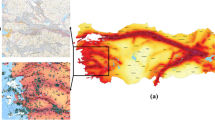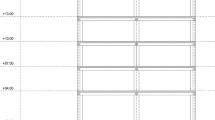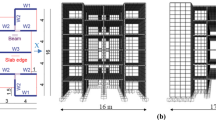Abstract
To obtain correctly, design of the structures under seismic loads, the methods of equivalent static and dynamic analyses are usually used. The assessment of the response of entire system soil-structure under seismic load is a fundamental step to anticipate losses and help to mitigate it. Some methods of the design of retaining walls under seismic loads require the knowledge of the maximum acceleration of seismic signal. The present work discusses these methods and a comparison with detailed analysis. Three configurations of a retaining wall at different heights were considered under seismic loading: 10 signals from the 2003 Boumerdes earthquake and the 1999 Ain-Témouchent earthquake (in Algeria). Then it was assessed the dynamic thrust forces given by the approximate methods for maximum acceleration of the considered earthquakes. The approximate methods used are the pseudo-static method, the method of Seed and Whitman, the approach given in the Algerian seismic code RPA99 and the Mononobe–Okabe method. The results show that the integration of time history of seismic loading to evaluate the dynamic active earth pressure behind retaining walls is very important and can transmit higher values than the seismic force calculated by the simplified methods. This demonstrates that an earthquake cannot be considered only by its maximum acceleration and to properly design the retaining structures, the developed energy during an earthquake must be taken into account.










Similar content being viewed by others
References
Bourdim SMA, Chekroun L, Benanane A, Bourdim A (2018) Treatment of a landslide by using piles system, case study of the East-West Highway of Algeria. In: Abdoun T, Elfass S (eds) Soil dynamics and soil-structure interaction for resilient infrastructure. Sustainable civil infrastructures. Springer, Cham, pp 16–24
AbbaszadehShahri A, Esfandiyari B, Hamzeloo H (2010) Evaluation of a nonlinear seismic geotechnical site response analysis method subjected to earthquake vibrations (case study: Kerman Province, Iran). Arab J Geosci 4:1103–1116. https://doi.org/10.1007/s12517-009-0120-7
Aliazad S, Yasrobi S, Pak A (2008) Seismic active pressure distribution history behind rigid retaining walls. Soil Dyn Earthq Eng 28(5):365–375. https://doi.org/10.1016/j.soildyn.2007.07.003
Ministry of Housing of Algeria (2003) "Règlement parasismique Algérien -RPA99- version 2003", DTR B C 2–48. (In French).
Okabe S (1924) General theory on earth pressure and seismic stability of retaining walls and dams. J Jpn Soc Civil Eng 10(6):1277–1323
Mononobe N, Matsuo M (1932) Experimental investigation of lateral earth pressure during earthquakes. Earthquake Research Institute and Research Office of Public Works, pp 884–902
Mononobe N, Matsuo O (1929) On the determination of earth pressure during earthquakes. In: Proceeding of the world engineering congress, Vol 9, Tokyo, pp 179–187
Heyman J (1997) Coulomb’s memoir on statics: an essay in the history of civil engineering. Imperial College Press, London
Saran S, Prakash S (1968) Dimensionless parameters for static and dynamic earth pressures behind retaining walls. Indian Geotech J 7(3):295–310
Saran S, Gupta RP (2003) Seismic earth pressures behind retaining walls. Indian Geotech J 33(3):195–213
Shukla SJ, Gupta SK, Sivakugan N (2009) Active earth pressure on retaining wall for c–φ soil backfill under seismic loading conditions. J Geotech Geoenviron Eng 135(5):690–696
Huntington WC (1957) Earth pressures and retaining walls. John Wiley and Sons, New York
Iskander M, Chen Z, Omidvar M, Guzman I, Elsherif O (2013) Active static and seismic earth pressure for c–φ soils. Soils Found 53(5):639–652. https://doi.org/10.1016/j.sandf.2013.08.003
Choudhury D, Nimbalkar S (2006) Pseudo-dynamic approach of seismic active earth pressure behind retaining wall. Geotech Geol Eng 24:1103–1113. https://doi.org/10.1007/s10706-005-1134-x
Choudhury D, Subba Rao KS (2002) Seismic passive resistance in soils for negative wall friction. Can Geotech J 39(4):971–981. https://doi.org/10.1139/T02-023
Subba Rao KS, Nayak S, Choudhury D (2004) Determination of displacement-related passive earth pressure. Geotech Eng 35(2):79–85
Al-Homoud AS, Whitman RV (1994) Comparison between FE prediction and results from dynamic centrifuge tests on tilting gravity walls. Soil Dyn Earthq Eng 14(323):259–268
Gazetas G, Sarropoulos PN, Anastasapoulos I, Gerolymos N (2004) Soil behavior of flexible retaining systems subjected to short-duration moderately strong excitation. Soil Dyn Earthq Eng 24:537–550
Psarropoulos PN, Klonaris G, Gazetas G (2005) Seismic earth pressures on rigid and flexible earth retaining walls. Soil Dyn Earthq Eng 25:795–809
Madabhushi SPG, Zeng X (2007) Simulating seismic response of cantilever retaining walls. J Geotechn Geoenviron Eng 133(5):539–549
Tiznado JC, Rodriguez-Roa F (2011) Seismic lateral movement prediction for gravity retaining walls on granular soils. Soil Dyn Earthq Eng 31:391–400
Sitar N, Mikola R, Candia G (2012) Seismically induced lateral earth pressure on retaining structures and basement walls. In: Proceedings of GSP no. 226, pp 335–358
Anderson DG, Martin GR, Lam IP, Wang JN (2008) Seismic design and analysis of retaining walls, buried structures, slopes and embankments. NCHRP Report 611. Transportation research board, National cooperative highway research program, Washington DC
Iskander M, Omidvar M, Elsherif O (2012) Conjugate stress approach for Rankine seismic active earth pressure in cohesionless soils. J Geotech Geoenviron Eng 139(7):1205–1210
Costet J, Sanglerat G (1969) Cours pratique de mécanique des sols. Dunod, Paris
Robert WD (2002) Geotechnical earthquake engineering handbook. Mc-Graw Hill Book Company, USA
Choudhury D, Chatterjee S (2006) Dynamic active earth pressure on retaining structures. Sadhana 31:721–730. https://doi.org/10.1007/BF02716891
Cakir T (2017) Assessment of effect of material properties on seismic response of a cantilever wall. Geomech Eng 13(4):601–619
Brinkgereve RBJ, Vermeer PA (2003) PLAXIS Version 8, Scientific manual. Delft University of Technology, Pays-Bas, PLAXIS BV
Brinkgereve RBJ, Vermeer PA (2003) PLAXIS Version 8, Dynamics manual. Delft University of Technology, Pays-Bas, PLAXIS BV
Bourdim SMA, Boumechra N, Djedid A (2016) Numerical model calibration, case of dynamic behavior of a soil-retaining wall system. J Mater Environ Sci 7(3):1048–1055
Belghit A, Bourdim SMA, Benanane A, Bouhamou N (2020) Study of slope stability using piles pathological case in Mostaganem, Algeria. In: Pinto P, Ou CY, Shehata H (eds) Innovative solutions for deep foundations and retaining structures. GeoMEast 2019. Sustainable civil infrastructures. Springer, Cham
S.M.A. Bourdim and Y. Zelmate (2016) Earthquake analysis of an old minaret under real and synthetic accelerograms. Cinpar2016: XII International conference on structural repair and rehabilitation, 26–29 October 2016, Porto, Portugal
Bourdim SMA, Hamdaoui K, Marcellini A (2013) Diagnosis and seismic analysis of the Mansourah minaret in Tlemcen, Algeria. Int J Civil Eng Res 4(2):153–175
Hamdaoui K, Benadla Z (2014) Dynamic analysis of a historical monument: retrofit using shape memory alloy wires. Smart Struct Syst 13(3):375–388
EsmaeilAbadi R, AbasszadehShahri A, Behzadafshar K (2015) Frequency content analysis of the probable earthquake in Kopet Dagh region—Northeast of Iran. Arab J Geosci 8:3833–3844. https://doi.org/10.1007/s12517-014-1446-3
Laouami N, Slimani A, Bouhadad Y, Chatelain J, Nour A (2006) Evidence for fault-related directionality and localized site effects from strong motion recordings of the 2003 Boumerdes (Algeria) earthquake. Soil Dyn Earthq Eng 26(11):991–1003. https://doi.org/10.1016/j.soildyn.2006.03.006
Esmaeilabadi R, AbbaszadehShahri A (2016) Prediction of site response spectrum under earthquake vibration using an optimized developed artificial neural network model. Adv Sci Technol Res J 10(30):76–83
Asheghi R, Abbas Hosseini S, Mojtaba S, AbbaszadehShahri A (2020) Updating the neural network sediment load models using different sensitivity analysis methods: a regional application. J Hydroinf 22(3):562–577. https://doi.org/10.2166/hydro.2020.098
Author information
Authors and Affiliations
Corresponding author
Ethics declarations
Conflict of interest
On behalf of all authors, the corresponding author states that there is no conflict of interest.
Rights and permissions
About this article
Cite this article
Bourdim, S.M.EA., Boumechra, N., Djedid, A. et al. Effect of spatio-temporal variability of the seismic signal on the dynamic pressure behind retaining walls. Innov. Infrastruct. Solut. 7, 35 (2022). https://doi.org/10.1007/s41062-021-00626-6
Received:
Accepted:
Published:
DOI: https://doi.org/10.1007/s41062-021-00626-6




